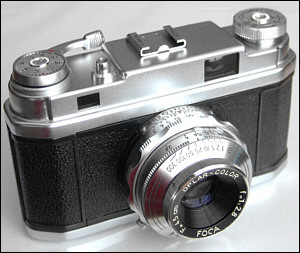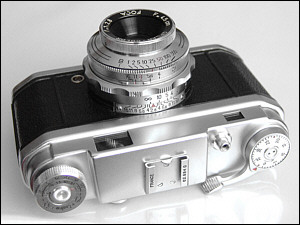
Foca Sport II: The French Connection

The Foca Sport II -- a very nice fixed-lens rangefinder.
The camera body is 5 inches wide, 3 inches high and 1 1/4 inches deep.
In metric, that is 13cm wide, 7.4cm high and 3cm deep. The lens extends
from the body 1 1/4 inches or 3cm.
One day, I was reading an article on some French photographers when the Foca camera was
mentioned.
This made me curious. Exactly what is a Foca?
Simply put, it's a series of cameras that
were made in France, some featuring focal plane shutters and interchangeable
lenses and rangefinder focusing and other simpler cameras with zone focusing,
leaf shutters and sometimes a selenium meter.
I found this particular camera on eBay, but I kept my expectations low.
While the camera looked nice, a Web site photo doesn't always tell the whole
story, and often what you see isn't exactly what you get, as those of us who
buy cameras now know. No such problems with this camera.
The Foca Sport II arrived in a small brown box and included the case, a
black rubber Foca lens cap, a metal lens shade, a green filter and a
close-up lens. I haven't yet tried the close-up lens. All of the accessories
are of the push-on variety. The lens hood is marked 36, so I assume the
outside diameter of the lens is 36mm.
The Foca Sport II was made in the early 1960s, and the accessory shoe on
my camera is marked 62.xxxx, which might indicate that it was made in 1962.
This camera has no meter, so
you'll want to have a handheld meter or you can guess. There also are no strap
lugs on the body, as I imagine that Foca intended for the photographer to
use it in its ever-ready case.
The Sport II has lever wind, a coated lens and a fairly wide-base
rangefinder, which appears to be about 58mm. A wider rangefinder base
provides for more accurate focusing. I'm not sure what the viewfinder
magnification is ... probably about 0.7x, which puts the effective
rangefinder base at roughly 40mm -- still quite wide for a fixed-lens
camera. As you can see in the photo below, the rangefinder window is
situated near the end of the camera, so keep your
fingers out of the way.

The Foca Sport II -- no surprise with the controls. Simple elegance in its
operation.
The between-the-lens leaf shutter has an impressively wide range speeds
running from 1/300 to one second plus B and is flash synchronized. Rewind is
via a knob on top of the camera, and a slide switch on the bottom of the
camera allows the back to be removed for changing film. The film spool is
fixed, so there won't be any of that nonsense of the spool falling out of
the camera and rolling down the street with the photographer in hot pursuit
and then looking rather forlorn as it rolls into the sewer.
The coated f/2.8 4.5cm Oplar-Color focuses easily via the large knurled
ring. A depth of field scale on the lens barrel helps the photographer take
advantage of hyperfocal settings. Being a European camera, the distance scale is
marked in meters although the film speed minder dial atop the rewind knob is
conveniently marked with both DIN and ASA numbers.
Apertures are changed by using the small tab under the lens. There are
clicks for full stops only, although you can always set the aperture between
the stops, if desired.
When holding the camera, you have to tilt the camera toward the sky to
see the shutter speeds and apertures. No big deal, especially for those who
have used a variety of cameras.
The unified rangefinder/viewfinder is to the left and contains no frame
lines. That's a bit of a short-coming, because by the 1960s most camera
makers were including frame lines in their viewfinder cameras. Focusing the camera is
very simple. The rangefinder system uses mirrors to create the secondary
image.
The film advance requires a single-throw, and the sprung lever neatly
returns
to its starting point, hopefully without poking you in the eye. There is no
"standoff" position for the film advance lever.
I can't say enough nice things about the Foca Sport II. The body feels
very solid with no flex. Choice of materials is excellent. The satin chrome
finish on my camera has held up very well, and the body covering, which
appears to be leather, provides for a nice surface visually and
ergonomically.
Using the Foca Sport II
I'd rather use a camera than fondle it, so off I went with a
roll of Agfapan APX100 on a cool February day. The camera was simple to
load, although the slide switch on the bottom of the plate requires moderate
effort to lock ("O" = ouvrir and "F" = fermer) and unlock. Even off the
camera, the slide switch isn't easy to move, and I suppose this makes sense,
as it's your last line of defense between you and the back falling off the
camera moments after you take that award-winning photograph.
Film runs left to right, and the takeup spool has some knurling that
allows you to get the film leader set correctly. Replace the back, which
took a bit of fiddling -- ahh, there it is ... lock the back. Fire two
blanks and reset the film counter. It's of the countdown variety, so you set
the total number of exposures at the start, and then at a glance you know how many
frames you have left. There are numerical indicators for every five frames
with hash marks for those between. Simple enough.
Out on the street, the leaf shutter is very quiet -- as you would expect
it to be. On the higher speeds, the shutter sounds more like "crick" rather
than "click" and the shutter release has a crunchy feel to it. It's not bad
-- it's just different. The shutter release is smooth and predictive.
Turning the aperture ring is
stiffer than I would have liked. There's certainly no chance of it being
knocked off its setting by accident.
The body is somewhat small, so it was easy to move around on the streets
of Pittsburgh without attracting unwanted attention. Focusing the camera was
a breeze, and the viewfinder is clear. There are no framelines or parallax
indicators, so you just have to use your best guess on closeups.
Overall, the Foca Sport II is a very enjoyable camera to use. The lens is
sharp. The controls are just where you expect them to be. And there were no
unpleasant surprises while using the camera.
Servicing the camera
It's been a while since I serviced the Foca Sport II. As I
recall, this camera had two problems: None of the slow speeds worked at all,
and the rangefinder needed to be calibrated and was out vertically. I guess
that's three problems.
It took me some time to get the shutter to fire correctly.
It's a different design from what you find in a Pronto or Compur. But that
wasn't the problem. The primary issue was what appeared to be a sticky
substance that covered most of the parts. Once I cleaned all of the parts,
the shutter ran smoothly and continues to fire smoothly more than a year
after it was serviced.
Cleaning the viewfinder and rangefinder and adjusting the
rangefinder was no problem. Correcting the vertical misalignment was a bit
of a problem. You have to alter the angle of either the semi-gilded mirror
or the secondary mirror to correct for vertical alignment. I kept trying to
bend its support carefully, but it always seemed to move back to its
original incorrect spot. Finally, I just moved it sharply, and that seemed
to do the trick. I don't recommend this approach, even though it worked for
this camera.
The rest of the work was routine: Cleaning the lens, the
leather covering and the interior. I finished by collimating the lens. I've
given some thought to possibly cleaning and relubricating the lens helical, but it focuses
smoothly enough, so I've decided not to mess with it now.
|